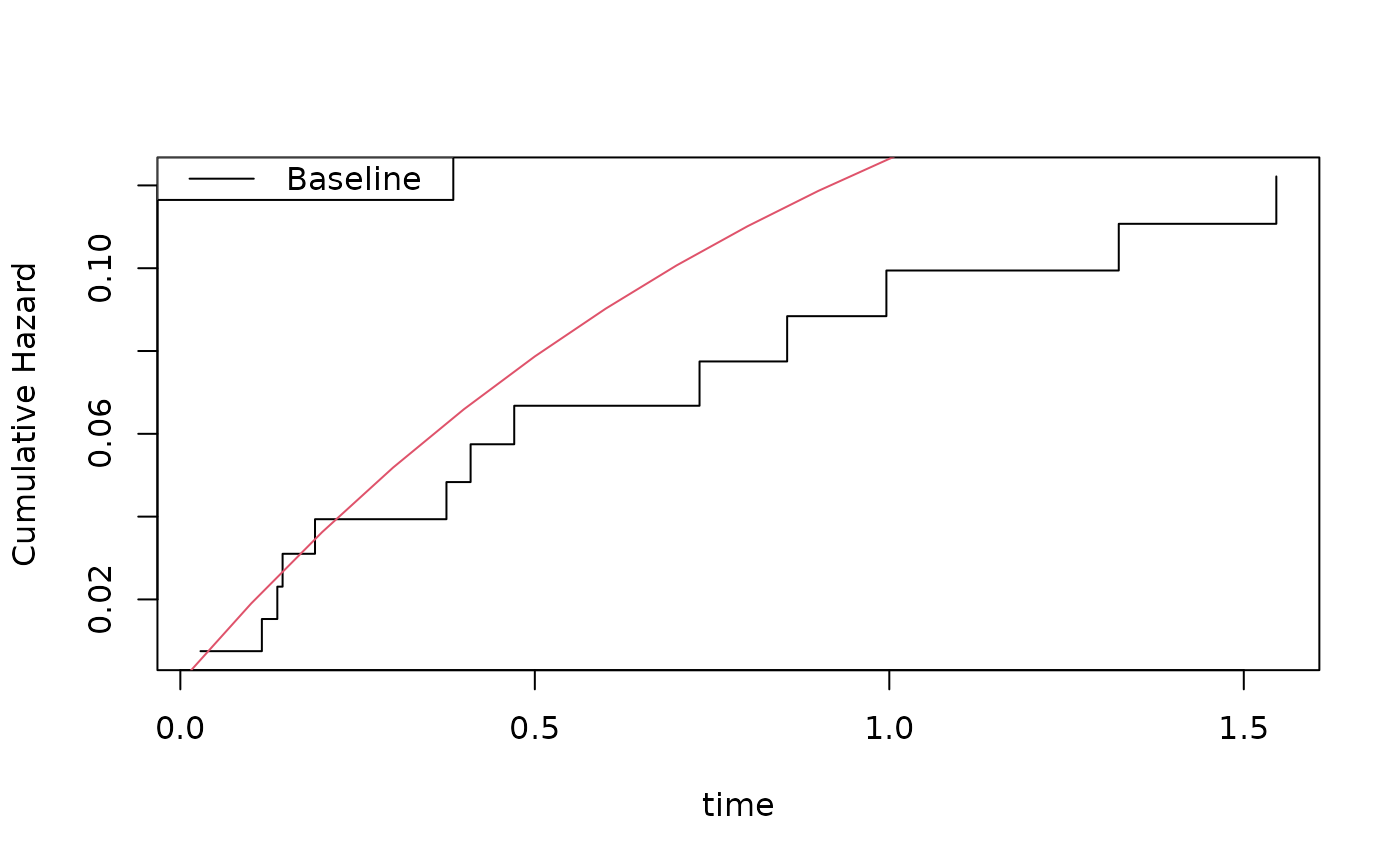
Augmentation for Fine-Gray model based on stratified NPMLE Cif (Aalen-Johansen)
Source:R/cifreg.R
FG_AugmentCifstrata.RdComputes the augmentation term for each individual as well as the sum $$ A(\beta) = \int H(t,X,\beta) \frac{F_2^*(t,s)}{S^*(t,s)} \frac{1}{G_c(t)} dM_c $$ with $$ H(t,X,\beta) = \int_t^\infty (X - E(\beta,t) ) G_c(t) d\Lambda_1^*i(t,s) $$ using a KM for $$G_c(t)$$ and a working model for cumulative baseline related to $$F_1^*(t,s)$$ and $$s$$ is strata, $$S^*(t,s) = 1 - F_1^*(t,s) - F_2^*(t,s)$$, and $$E(\beta^p,t)$$ is given. Assumes that no strata for baseline of ine-Gay model that is augmented.
Usage
FG_AugmentCifstrata(
formula,
data = data,
E = NULL,
cause = NULL,
cens.code = 0,
km = TRUE,
case.weights = NULL,
weights = NULL,
offset = NULL,
...
)Arguments
- formula
formula with 'Event', strata model for CIF given by strata, and strataC specifies censoring strata
- data
data frame
- E
from FG-model
- cause
of interest
- cens.code
code of censoring
- km
to use Kaplan-Meier
- case.weights
weights for FG score equations (that follow dN_1)
- weights
weights for FG score equations
- offset
offsets for FG model
- ...
Additional arguments to lower level funtions
Details
After a couple of iterations we end up with a solution of $$ \int (X - E(\beta) ) Y_1(t) w(t) dM_1 + A(\beta) $$ the augmented FG-score.
Standard errors computed under assumption of correct $$G_c$$ model.
Examples
library(mets)
set.seed(100)
rho1 <- 0.2; rho2 <- 10
n <- 100
beta=c(0.0,-0.1,-0.5,0.3)
dats <- simul.cifs(n,rho1,rho2,beta,rc=0.2)
dtable(dats,~status)
#>
#> status
#> 0 1 2
#> 6 13 81
#>
dsort(dats) <- ~time
fg <- cifreg(Event(time,status)~Z1+Z2,data=dats,cause=1,propodds=NULL)
summary(fg)
#>
#> n events
#> 100 13
#>
#> 100 clusters
#> coeffients:
#> Estimate S.E. dU^-1/2 P-value
#> Z1 -0.25559 0.27563 0.28698 0.3538
#> Z2 0.43883 0.55113 0.57407 0.4259
#>
#> exp(coeffients):
#> Estimate 2.5% 97.5%
#> Z1 0.77446 0.45121 1.3293
#> Z2 1.55089 0.52658 4.5677
#>
plot(fg); lines(attr(dats,"Lam1"),col=2)
 fgaugS <- FG_AugmentCifstrata(Event(time,status)~Z1+Z2+strata(Z1,Z2),data=dats,cause=1,E=fg$E)
summary(fgaugS)
#>
#> n events
#> 100 13
#>
#> 100 clusters
#> coeffients:
#> Estimate S.E. dU^-1/2 P-value
#> Z1 -0.25559 0.27360 0.28698 0.3502
#> Z2 0.43883 0.54675 0.57407 0.4222
#>
#> exp(coeffients):
#> Estimate 2.5% 97.5%
#> Z1 0.77446 0.45301 1.3240
#> Z2 1.55089 0.53111 4.5287
#>
fgaugS2 <- FG_AugmentCifstrata(Event(time,status)~Z1+Z2+strata(Z1,Z2),data=dats,cause=1,E=fgaugS$E)
summary(fgaugS2)
#>
#> n events
#> 100 13
#>
#> 100 clusters
#> coeffients:
#> Estimate S.E. dU^-1/2 P-value
#> Z1 -0.25559 0.27360 0.28698 0.3502
#> Z2 0.43883 0.54675 0.57407 0.4222
#>
#> exp(coeffients):
#> Estimate 2.5% 97.5%
#> Z1 0.77446 0.45301 1.3240
#> Z2 1.55089 0.53111 4.5287
#>
fgaugS <- FG_AugmentCifstrata(Event(time,status)~Z1+Z2+strata(Z1,Z2),data=dats,cause=1,E=fg$E)
summary(fgaugS)
#>
#> n events
#> 100 13
#>
#> 100 clusters
#> coeffients:
#> Estimate S.E. dU^-1/2 P-value
#> Z1 -0.25559 0.27360 0.28698 0.3502
#> Z2 0.43883 0.54675 0.57407 0.4222
#>
#> exp(coeffients):
#> Estimate 2.5% 97.5%
#> Z1 0.77446 0.45301 1.3240
#> Z2 1.55089 0.53111 4.5287
#>
fgaugS2 <- FG_AugmentCifstrata(Event(time,status)~Z1+Z2+strata(Z1,Z2),data=dats,cause=1,E=fgaugS$E)
summary(fgaugS2)
#>
#> n events
#> 100 13
#>
#> 100 clusters
#> coeffients:
#> Estimate S.E. dU^-1/2 P-value
#> Z1 -0.25559 0.27360 0.28698 0.3502
#> Z2 0.43883 0.54675 0.57407 0.4222
#>
#> exp(coeffients):
#> Estimate 2.5% 97.5%
#> Z1 0.77446 0.45301 1.3240
#> Z2 1.55089 0.53111 4.5287
#>